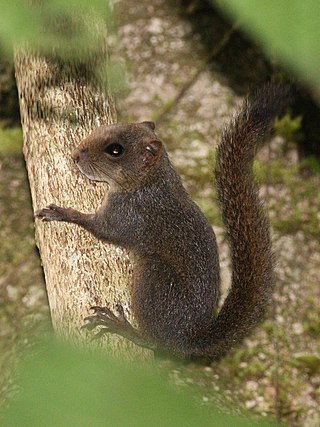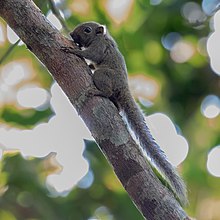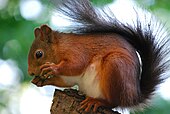
Sciurinae is a subfamily of squirrels, uniting the flying squirrels with certain related tree squirrels. Older sources place the flying squirrels in a separate subfamily (Pteromyinae) and unite all remaining sciurids into the subfamily Sciurinae, but this has been strongly refuted by genetic studies.

The genus Sciurus contains most of the common, bushy-tailed squirrels in North America, Europe, temperate Asia, Central America and South America.

The Amazon dwarf squirrel is a chipmunk-sized tree squirrel native to South America.

The Neotropical pygmy squirrel is a South American species of tree squirrel, being the only living species in the genus Sciurillus and the subfamily Sciurillinae. Genetic analysis has shown it to be the sister group to all other squirrels.
The short-tailed spiny-rat or Huallaga spiny rat, is a spiny rat species found in Bolivia, Brazil, Colombia, Ecuador and Peru.

The Guyenne spiny-rat or Cayenne spiny rat, is a spiny rat species found in Brazil, Colombia, French Guiana, Guyana, Suriname and Venezuela.

The Napo spiny rat is a spiny rat species found in Brazil, Colombia, Ecuador, Peru and Venezuela.

Simons's spiny rat is a spiny rat species found in Bolivia, Brazil, Colombia, Ecuador and Peru. It was named for American scientific collector Perry O. Simons.
Sigmodontomys alfari, also known as the short-tailed sigmodontomys, Alfaro's rice water rat, Cana rice rat, or Allen's rice rat, is a species of rodent in the subfamily Sigmodontinae of family Cricetidae. It is found from Honduras through Nicaragua, Costa Rica, and Panama into South America, where it occurs from Venezuela through Colombia to Ecuador.

The Central American dwarf squirrel, also known as Alfaro's pygmy squirrel, is a small tree squirrel in the genus Microsciurus and tribe Sciurini found in Colombia, Costa Rica, Nicaragua, and Panama. No species of squirrel within this genus are listed as endangered, however they are rarely seen because they are extremely elusive. This suggests that their population numbers may be larger than documented.

The western dwarf squirrel is a small tree squirrel in the genus Microsciurus and tribe Sciurini found in Colombia, Ecuador, and Panama.

The Santander dwarf squirrel is a small tree squirrel endemic to Colombia.
The Colombian spiny-rat is a species of rodent in the family Echimyidae. It is found in Colombia and Venezuela.
The Boyacá spiny rat is a species of rodent in the family Echimyidae. It is endemic to Colombia; it is found primary forest in Carare River valley, Boyacá Department, 100 to 500 meters above sea level. Nocturnal, terrestrial and solitary, it feeds on seeds, fruit and some leaves and insects. It is threatened by habitat loss for mining and agriculture.
The Magdalena spiny rat is a species of rodent in the family Echimyidae. It is endemic to Colombia.
The Minca spiny rat is a species of rodent in the family Echimyidae. It is endemic to Colombia.
O'Connell's spiny-rat is a species of rodent in the family Echimyidae. It is endemic to Colombia.
The gray-footed spiny rat is a species of rodent in the family Echimyidae. It is found in Colombia and Venezuela.

The brown hairy dwarf porcupine is a species of rodent in the family Erethizontidae. Found in the Andes in Colombia and Venezuela, its natural habitat is subtropical or tropical moist lowland forests. It is not easy to study as it is known only from a few specimens and was not recorded from 1925 until the 2000s. The porcupine is nocturnal and arboreal, feeding on leaves, shoots, and fruits. Habitat loss severely threatens it, and it may even be extinct. Formerly listed as vulnerable, it is now designated data deficient. It is not known from any protected areas or conservation measures.














